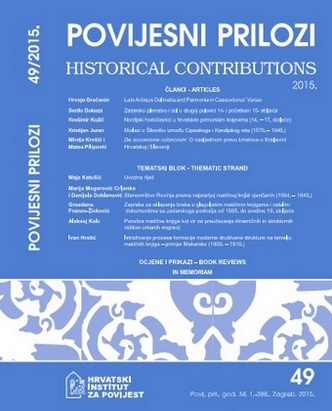Istraživanje procesa formacije moderne društvene strukture na temelju matičnih knjiga – primjer Makarske (1900. – 1910.)
Researching the Formation of Modern Social Structure on the Basis of Registry Books: The Case of Makarska (1900 – 1910)
Author(s): Ivan HrstićSubject(s): Social history, Recent History (1900 till today), Pre-WW I & WW I (1900 -1919)
Published by: Hrvatski institut za povijest
Keywords: modernization; social structure; social mobility; registry books
Summary/Abstract: Historical demography and registry books as sources can undoubtedly offer an important insight into the direction, speed, and intensity of the formation of modern social structure, that is, the transformation of the traditional social structure into a modern one. However, this type of research is significantly limited in terms of methodology. Changes that occurred during the process are reflected primarily in the system of social stratification. This resulted in various changes in the professional structure of the population, which can be observed only in male population, since men were still the carriers of the family status in the Croatian lands during the 19th and the first decades of the 20th century. This has been confirmed by the analysis of vertical social mobility of the population of Makarska, performed on the basis of marriage registry books from 1900-1910. The analysis has shown that the evolution of modern social structure in this area started during the second half of the 19th century. The beginning stage of this process was characterized by a relatively fast expansion of the middle social layer, owing to the slow industrialization process. Therefore, in case of Makarska, the main motor of modernization was the city’s role as the regional trade and administration centre. Slow industrialization process was not a specificity of Makarska alone, but a feature of other Croatian lands and a large part of the Austrian-Hungarian Monarchy as well. Thus, the main feature of social modernization in the area as a whole was an exceptionally slow increase in the number of workers from the lower social layers, as well as the prolonged presence of peasants in the overall professional structure. In the Croatian lands, this inertia was particularly manifest during the aforesaid period, since the Croatian society was a European periphery in a twofold sense: it was situated at the periphery of a state that was, in terms of modernization, itself a part of European periphery. The result was an absolute prevalence of peasants in its population as a whole, which would remain the main feature of social structure in most Croatian lands until World War II.
Journal: Povijesni prilozi
- Issue Year: 2015
- Issue No: 49
- Page Range: 331-352
- Page Count: 22
- Language: English, Croatian

